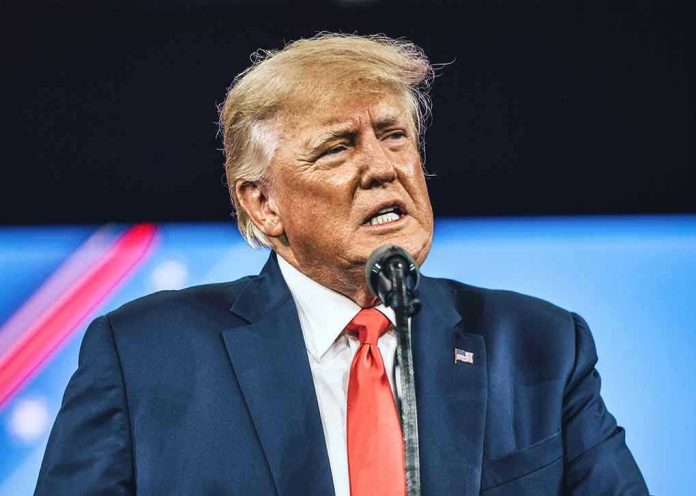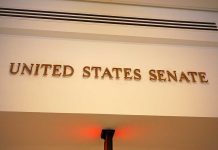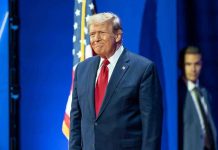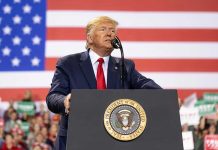
When a statue of Donald Trump and Jeffrey Epstein holding hands appeared again on the National Mall, it wasn’t just art—it was a battle cry hurled into America’s most sacred public space, demanding the nation stare down the ghosts of power, scandal, and accountability.
Story Snapshot
- Provocative Trump-Epstein statue reemerges on the National Mall, reigniting political debate
- Guerrilla art blurs the line between protest, public memory, and scandal
- Authorities swiftly remove installation, but debate over its meaning intensifies
- Anonymous artists and activists challenge the boundaries of public expression—and national discomfort
The National Mall as America’s Political Canvas
The National Mall—normally a backdrop for school field trips and tourist selfies—witnessed the return of a statue designed to provoke. Lifelike figures of Donald Trump and Jeffrey Epstein, hands clasped, materialized without warning. The figures, eerily realistic, dared passersby to question what power, complicity, and memory look like in bronze and resin. This was not the statue’s debut.
By mid-morning, the statue had drawn an audience. Some gawked, some raged, some snapped photos for social media. The National Park Service cited safety and regulations as it removed the unauthorized installation, but not before the scene was immortalized online. Journalists staked out the Mall, capturing reactions and stoking the flames of controversy. The city buzzed with speculation: Who placed it? Why now? Had anything changed since its last appearance?
Guerrilla Art and the Shadow of Scandal
The Trump-Epstein statue is not accidental art. Its anonymous creators clearly understand the potency of public symbolism. By evoking two figures tied together by headlines, rumors, and the unending churn of scandal, the work shoves uncomfortable truths into the daylight. Trump whose social orbit once included Epstein, has spent years distancing himself from the disgraced financier. Epstein, dead by suicide in a Manhattan jail, remains an emblem of elite impunity and conspiracy. Their joined hands on federal land speak to unresolved national questions—about justice, about who wields power, and about what America chooses to remember or forget.
The Mall has always served as a contested stage. From antiwar protests to civil rights marches, it’s the theater where American democracy debates itself. But guerrilla art like this takes a different tack. It sidesteps permits and officialdom, relying instead on shock, ambiguity, and viral spread. Art critics have compared the Trump-Epstein work to the “Naked Trump” statues of 2016, or to Banksy’s political interventions abroad. Yet this piece, with its explicit allusion to abuse of power, lands with a heavier thud—especially in a polarized nation still sorting through the aftermath of #MeToo and the Trump presidency.
Power, Order, and the Politics of Memory
Official response arrived on cue. The National Park Service, guardians of the Mall’s order, removed the statue within hours. Their statement was brisk: unauthorized installations would be cleared to protect public safety and preserve federal property. Law enforcement began scouring security footage to identify those responsible, hinting at legal consequences. Meanwhile, on social media, a statement attributed to the anonymous artist declared, “We will not be silenced. Art is protest.” The confrontation laid bare the tension between free expression and institutional control—a dance as old as the Mall itself.
Trump-Epstein statue returns to National Mall after removal by National Park Service | Click on the image to read the full story https://t.co/ilxauUAW6b
— kcranews (@kcranews) October 3, 2025
For Trump and his circle, the statue’s reappearance was an unwelcome reminder of lingering allegations and unresolved narratives. For survivors of abuse, its presence could both retraumatize and empower, forcing society to grapple with its complicity or indifference. The general public, caught in the crossfire of symbolism, was once again asked to consider what kind of memory—what kind of justice—should be displayed in America’s front yard.
Political Theater, Public Reckoning
The statue’s impact didn’t end with its removal. In the days that followed, media coverage exploded. Commentators from across the spectrum seized upon the incident: some decried it as tasteless provocation, others hailed it as necessary confrontation. Political figures used the event to score points—either as proof of ongoing persecution or as a symbol of elite corruption. Art critics and academics weighed in, situating the statue within a long tradition of protest art meant to disrupt, unsettle, and force dialogue.
Though the statue is gone, the forces it unleashed remain. On the National Mall, the battle over memory, power, and accountability continues—one sculpture, one protest, one viral image at a time. The next eruption, as history shows, is only ever one midnight delivery away.
Sources:
The Washington Post, “Controversial Trump-Epstein Statue Reappears on National Mall,” October 2025.
Reuters, “Guerrilla Art Installation Removed from National Mall,” October 2025.
National Park Service, Official Press Release, October 2025.










